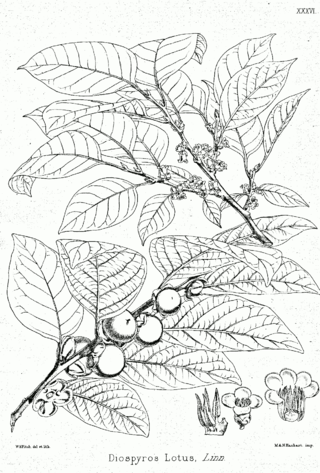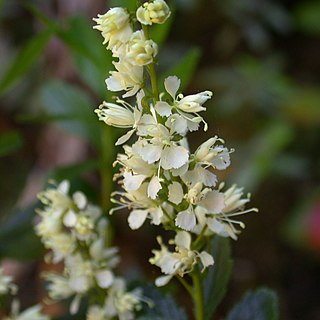
The Dioscoreales are an order of monocotyledonous flowering plants, organized under modern classification systems, such as the Angiosperm Phylogeny Group or the Angiosperm Phylogeny Web. Among monocot plants, Dioscoreales are grouped with the lilioid monocots, wherein they are a sister group to the Pandanales. In total, the order Dioscoreales comprises three families, 22 genera and about 850 species.

The Poales are a large order of flowering plants in the monocotyledons, and includes families of plants such as the grasses, bromeliads, rushes and sedges. Sixteen plant families are currently recognized by botanists to be part of Poales.

The Zingiberales are flowering plants forming one of four orders in the commelinids clade of monocots, together with its sister order, Commelinales. The order includes 68 genera and 2,600 species. Zingiberales are a unique though morphologically diverse order that has been widely recognised as such over a long period of time. They are usually large herbaceous plants with rhizomatous root systems and lacking an aerial stem except when flowering. Flowers are usually large and showy, and the stamens are often modified (staminodes) to also form colourful petal-like structures that attract pollinators.

Ebenales is an order of flowering plants. This order was recognized in several systems, for example the Bentham & Hooker system and the Engler system, although the Wettstein system preferred the name Diospyrales'. In the 1981 version of the Cronquist system it was an order placed in subclass Dilleniidae with the following circumscription:

LiliopsidaBatsch is a botanical name for the class containing the family Liliaceae. It is considered synonymous with the name monocotyledon. Publication of the name is credited to Scopoli : see author citation (botany). This name is formed by replacing the termination -aceae in the name Liliaceae by the termination -opsida.

Orchidales is an order of flowering plants. In taxonomical systems, this is a relatively recent name as early systems used descriptive botanical names for the order containing the orchids. The Bentham & Hooker and the Engler systems had the orchids in order Microspermae while the Wettstein system treats them as order Gynandrae. Circumscription of the order will vary with the taxonomic system being used. Although mostly the order will consist of the orchids only, sometimes other families are added:

The Clusiaceae or GuttiferaeJuss. (1789) are a family of plants including 13 genera and ca 750 species. Several former members of Clusiacae are now placed in Calophyllaceae and Hypericaceae. They are mostly trees and shrubs, with milky sap and fruits or capsules for seeds. The family is primarily tropical. More so than many plant families, it shows large variation in plant morphology. According to the APG III, this family belongs to the order Malpighiales.

Ochnaceae is a family of flowering plants in the order Malpighiales. In the APG III system of classification of flowering plants, Ochnaceae is defined broadly, to include about 550 species, and encompasses what some taxonomists have treated as the separate families Medusagynaceae and Quiinaceae. In a phylogenetic study that was published in 2014, Ochnaceae was recognized in the broad sense, but two works published after APG III have accepted the small families Medusagynaceae and Quiinaceae. These have not been accepted by APG IV (2016).

A taxonomic system, the Bentham & Hooker system for seed plants, was published in Bentham and Hooker's Genera plantarum ad exemplaria imprimis in herbariis kewensibus servata definita in three volumes between 1862 and 1883.
Parietales is an order of flowering plants. It is a descriptive botanical name for placentae parietales that characterised those plants. Thus it could be used even today. The termination -ales is only coincidentally identical to that appropriate to the rank of order.

Microspermae is an order of flowering plants. It is a descriptive botanical name referring to the size of the seed; it was used for the order containing the orchids.

Gynandrae is a botanical name of an order of flowering plants. It was used in the Wettstein system for the order containing the orchids and is a descriptive name referring to the stamens. The Bentham & Hooker and the Engler systems also used a descriptive name for this order, but preferred the name Microspermae.
A system of plant taxonomy, the Bessey system was published by Charles Bessey in 1915.

Lilianae is a botanical name for a superorder of flowering plants. Such a superorder of necessity includes the type family Liliaceae. Terminations at the rank of superorder are not standardized by the International Code of Nomenclature for algae, fungi, and plants (ICN), although the suffix -anae has been proposed.

Scitamineae is a descriptive botanical name. Historically it has been applied to a remarkably stable group of flowering plants, now referred to as Zingiberales:
Sladeniaceae is a family of flowering plants containing tree species found in subtropical to tropical environments in East Africa (Ficalhoa), Burma, Yunnan, and Thailand (Sladenia). The family consists of trees with alternate, simple leaves without stipules, and flowers arranged in cymose inflorescences.
Pentaphylax is a genus of flowering plants, with one or two species which are shrubs and small trees. The species has simple evergreen leaves that are alternately arranged on the stems. The flower pistil is 5 celled and the anthers dehiscing via pores and basifixed. Flowers have five petals and five sepals that are distinct from each other and five stamens attached oppositely to the sepals. The seeds are winged.

Tetracarpaea is the only genus in the flowering plant family Tetracarpaeaceae. Some taxonomists place it in the family Haloragaceae sensu lato, expanding that family from its traditional circumscription to include Penthorum and Tetracarpaea, and sometimes Aphanopetalum as well.

The Amaryllidaceae are a family of herbaceous, mainly perennial and bulbous flowering plants in the monocot order Asparagales. The family takes its name from the genus Amaryllis and is commonly known as the amaryllis family. The leaves are usually linear, and the flowers are usually bisexual and symmetrical, arranged in umbels on the stem. The petals and sepals are undifferentiated as tepals, which may be fused at the base into a floral tube. Some also display a corona. Allyl sulfide compounds produce the characteristic odour of the onion subfamily (Allioideae).

Hypericum hookerianum, or Hooker's St. John's Wort, is a perennial shrub in the flowering plant family Hypericaceae native to eastern and southern Asia. The specific name hookerianum is named for William Jackson Hooker.














